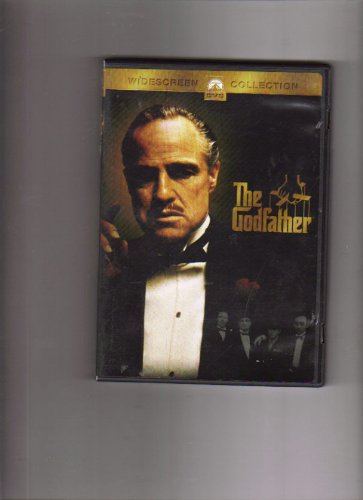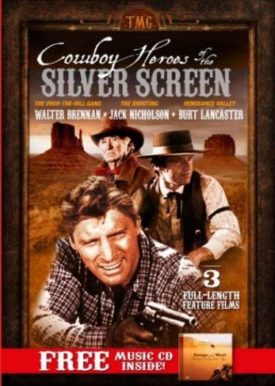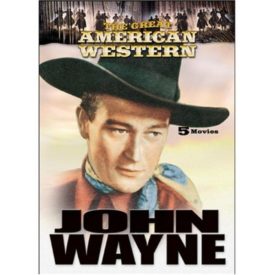Godfather (DVD)
Other Marketplace Price: $17.99Sale Price:$9.49
- Ships Same Day.
- FREE Shipping (U.S. Delivery).
- International Shipping (See Shipping Chart Below).
1 in stock
| Shipping US FREE SHIPPING |
FREE Shipping! |
|---|---|
| Shipping US Expedited 2-3 Day |
US Shipping: $14.99 Unlimited Items. |
| Shipping Canada |
Canada Shipping: Flat $34.99. |
| Shipping Int'l Standard | International Shipping: $64.99 Worldwide. |
| Shipping Local Pick Up |
FREE Local Pick Up in Store |
| Award | Category | Nominee | Result |
|---|---|---|---|
| 45th Academy Awards | Best Picture | Albert S. Ruddy | Won |
| Best Director | Francis Ford Coppola | Nominated | |
| Best Actor | Marlon Brando (declined award) | Won | |
| Best Supporting Actor | James Caan | Nominated | |
| Robert Duvall | Nominated | ||
| Al Pacino | Nominated | ||
| Best Adapted Screenplay | Mario Puzo and Francis Ford Coppola | Won | |
| Best Costume Design | Anna Hill Johnstone | Nominated | |
| Best Film Editing | William Reynolds and Peter Zinner | Nominated | |
| Best Sound | Bud Grenzbach, Richard Portman and Christopher Newman | Nominated | |
| Best Original Dramatic Score | Nino Rota | Revoked | |
| 26th British Academy Film Awards | Best Actor | Marlon Brando (Also for The Nightcomers) | Nominated |
| Best Supporting Actor | Robert Duvall | Nominated | |
| Most Promising Newcomer to Leading Film Roles | Al Pacino | Nominated | |
| Best Film Music | Nino Rota | Won | |
| Best Costume Design | Anna Hill Johnstone | Nominated | |
| 25th Directors Guild of America Awards | Outstanding Directorial Achievement in Motion Pictures | Francis Ford Coppola | Won |
| 30th Golden Globe Awards | Best Motion Picture – Drama | Won | |
| Best Director – Motion Picture | Francis Ford Coppola | Won | |
| Best Motion Picture Actor – Drama | Marlon Brando | Won | |
| Al Pacino | Nominated | ||
| Best Supporting Actor – Motion Picture | James Caan | Nominated | |
| Best Screenplay | Mario Puzo and Francis Ford Coppola | Won | |
| Best Original Score | Nino Rota | Won | |
| 15th Grammy Awards | Best Original Score Written for a Motion Picture or TV Special | Nino Rota | Won |
| 25th Writers Guild of America Awards | Best Drama Adapted from Another Medium | Mario Puzo and Francis Ford Coppola | Won |
American Film Institute recognition
- 1998 AFI s 100 Years...100 Movies – No. 3
- 2001 AFI s 100 Years...100 Thrills – No. 11
- 2005 AFI s 100 Years...100 Movie Quotes: I m going to make him an offer he can t refuse. – No. 2
- I m going to make him an offer he can t refuse. – No. 2
- 2006 AFI s 100 Years of Film Scores – No. 5
- 2007 AFI s 100 Years...100 Movies (10th Anniversary Edition) – No. 2
- 2008 AFI s 10 Top 10 – No. 1 Gangster Film
Other recognition
- 1990 Selected for preservation in the United States National Film Registry as being deemed culturally, historically, or aesthetically significant .
- 1992 The Godfather ranked 6th in Sight & Sound Greatest Films of All Time director s poll.
- 1998 Time Out conducted a poll and The Godfather was voted the best film of all time.
- The Village Voice ranked The Godfather at number 12 in its Top 250 Best Films of the Century list in 1999, based on a poll of critics.
- 1999 Entertainment Weekly named it the greatest film ever made.
- 2002 Sight & Sound polled film directors and they voted the film and its sequel as the second best film ever; the critics poll separately voted it fourth.
- 2002 The Godfather was ranked the second best film of all time by Film4, after Star Wars Episode V: The Empire Strikes Back.
- 2002 the film (along with The Godfather Part II) was voted at No. 39 on the list of the Top 100 Essential Films of All Time by the National Society of Film Critics.
- 2005 Named one of the 100 greatest films of the last 80 years by Time magazine (the selected films were not ranked).
- 2006 The Writers Guild of America, West agreed, voting it the number two in its list of the 101 greatest screenplays, after Casablanca.
- 2008 Voted in at No. 1 on Empire magazine s list of The 500 Greatest Movies of All Time.
- 2008 Voted at No. 50 on the list of 100 Greatest Films by the prominent French magazine Cahiers du cinéma.
- 2009 The Godfather was ranked at No. 1 on Japanese film magazine kinema Junpo s Top 10 Non-Japanese Films of All Time list.
- 2010 The Guardian ranked the film 15th in its list of 25 greatest arthouse films.
- 2012 The Motion Picture Editors Guild listed The Godfather as the sixth best-edited film of all time based on a survey of its membership.
- 2012 The film ranked at number seven on Sight & Sound directors top ten poll. On the same list it was ranked at number twenty one by critics.
- 2014 The Godfather was voted the greatest film in a Hollywood Reporter poll of 2120 industry members, including every studio, agency, publicity firm and production house in Hollywood in 2014.
- 2015 Second on the BBC s 100 Greatest American Films , voted by film critics from around the world.
Cultural influence and legacy
Although many films about gangsters preceded The Godfather, Coppola steeped his film in Italian immigrant culture, and his portrayal of mobsters as persons of considerable psychological depth and complexity was unprecedented. Coppola took it further with The Godfather Part II, and the success of those two films, critically, artistically and financially, was a catalyst for the production of numerous other depictions of Italian Americans as mobsters, including films such as Martin Scorsese s Goodfellas and TV series such as David Chase s The Sopranos.
A comprehensive study of Italian-American culture in film from 1914 to 2014 was conducted by the Italic Institute of America showing the influence of The Godfather. Over 81 percent of films, 430 films, featuring Italian Americans as mobsters (87 percent of which were fictional) had been produced since The Godfather, an average of 10 per year, while only 98 films were produced preceding The Godfather.
The Godfather epic, encompassing the original trilogy and the additional footage that Coppola incorporated later, has been thoroughly integrated into American life. Together with a succession of mob-theme imitators, it has resulted in a stereotyped concept of Italian-American culture biased toward the criminal networks. The first film had the largest effect. Unlike any film before it, its portrayal of the many poor Italians who immigrated to the United States in the early decades of the 20th century is perhaps attributable to Coppola and expresses his understanding of their experience. The films explore the integration of fictional Italian-American criminals into American society. Though set in the period of mass Italian immigration to America, the film explores the specific family of the Corleones, who live outside the law. Although some critics have considered the Corleone story to portray some universal elements of immigration, other critics have suggested that it resulted in viewers overly associating organized crime with Italian-American culture. Produced in a period of intense national cynicism and self-criticism, the film struck a chord about the dual identities felt by many descendants of immigrants. The Godfather has been cited as an influence in an increase in Hollywood s negative portrayals of immigrant Italians, and was a recruiting tool for organized crime.
The concept of a mafia Godfather was a creation of Mario Puzo, and the film resulted in this term being added to the common language. Don Vito Corleone s line, I m gonna make him an offer he can t refuse , was voted the second-most memorable line in cinema history in AFI s 100 Years...100 Movie Quotes by the American Film Institute, in 2014. The concept was not unique to the film. French writer Honoré de Balzac, in his novel Le Père Goriot (1835), wrote that Vautrin told Eugene: In that case I will make you an offer that no one would decline. An almost identical line was used in the John Wayne Western, Riders of Destiny (1933), where Forrest Taylor states, I ve made Denton an offer he can t refuse. In 2014, the film also was selected as the greatest film by 2,120 industry professionals in a Hollywood survey undertaken by The Hollywood Reporter.
Gangsters reportedly responded enthusiastically to the film. Salvatore Sammy the Bull Gravano, the former underboss in the Gambino crime family, said: I left the movie stunned ... I mean I floated out of the theater. Maybe it was fiction, but for me, then, that was our life. It was incredible. I remember talking to a multitude of guys, made guys, who felt exactly the same way. According to Anthony Fiato, after seeing the film, Patriarca crime family members Paulie Intiso and Nicky Giso altered their speech patterns to imitate that of Vito Corleone. Intiso was known to swear frequently and use poor grammar; but after seeing the movie, he began to improve his speech and philosophize more.
Representation in other media
The film has been referenced and parodied in various kinds of media.
- In The Good Life, Tom Good says about a rooster he intends to shoot, I m gonna make him an offer he can t refuse. .
- John Belushi appeared in a Saturday Night Live sketch as Vito Corleone in a therapy session; he said of the Tattaglia Family, Also, they shot my son Santino 56 times .
- In the television show The Sopranos, Tony Soprano s topless bar is named Bada Bing!, a phrase popularized by James Caan s character Sonny Corleone in The Godfather.
- In the animated television series The Simpsons, there have been many references to the film. For instance, in the season 3 episode Lisa s Pony , Lisa wakes up to find a horse in her bed and starts screaming, a reference to a scene in The Godfather. In the season 4 episode Mr. Plow , Bart Simpson is pelted with snowballs in mimicry of Sonny Corleone s killing.
- The film s baptism sequence was parodied in the season 4 episode Fulgencio , of the comedy series Modern Family.
- The 2006 video game The Godfather is based upon this film and tells the story of an original character, Aldo Trapani, whose rise through the ranks of the Corleone family intersects with the plot of the film on numerous occasions. Duvall, Caan, and Brando supplied voiceovers and their likenesses, but Pacino did not. Francis Ford Coppola openly voiced his disapproval of the game.
- On April 28, 2022, a 10-episode drama series The Offer premiered on Paramount+, about the production told from the perspective of producer Ruddy.
Film Notes
- The iconic cat that Marlon Brando holds when talking to the mortician in the wedding scene was not scripted. The cat wandered onto the set and Marlon picked up the cat before saying his lines.
New
B000USUA34
097360804928
1972
1972-03-24
175
2h 55min
Top rated movie #2 , Won 3 Oscars, 31 wins & 30 nominations total
Francis Ford Coppola
Mario Puzo, Francis Ford Coppola
Marlon Brando, Al Pacino, James Caan
Gray Frederickson, Albert S. Ruddy
Nino Rota
Gordon Willis
William Reynolds, Peter Zinner
Louis DiGiaimo, Andrea Eastman, Fred Roos
Dean Tavoularis
Warren Clymer
Richard Adee, Philip Smith
Anna Hill Johnstone
Philip Leto, Phil Rhodes, Dick Smith, Enrico A. Cortese
Fred C. Caruso, Valerio De Paolis, Ned Kopp
Tony Brandt, Fred T. Gallo, Paul Baxley, Stephen F. Kesten, Michael Rauch, Steven P. Skloot
Samuel Verts, William Canfield, Robert Hart, Robert Scaife
Charles Grenzbach, Christopher Newman, Richard Portman, Howard Beals, Steve Cook, Pierre Jalbert, Les Lazarowitz, Don MacDougall, Kitty Malone
Sass Bedig, A.D. Flowers, Tony Karp, Joe Lombardi, Paul J. Lombardi
Kevin Chaja, Chris Clausing, Padraic Culham, Daphne Dentz, Karina Desin, Joe Dubs, Lloyd Kaplowitz, Valerie McMahon, Mike Moreno, Edgar Orlino, Cathy Quiroz, Bill Roper, Steve Sanchez
Paul Baxley, Joe Bucaro III, Anthony Caso, Harry Daley
Michael Chapman, Bill Butler, Caleb Deschanel, Russell Engels, Ed Kammerer, Edward Knott, Jim Meyerhoff, Anthony R. Palmieri, Ed Quinn, Robert Royal, Joe Rutledge, Peter Salim, Tibor Sands, Jack Stager, Edward Tonkin, Robert M. Volpe, Dusty Wallace, Robert Ward, Ray Williams
Riccardo Bertoni
George Newman, Marilyn Putnam, Joan Joseff
Christopher Gillaspie, Kathleen Largay, Walter Murch, Jan Yarbrough, Pierre Jalbert, Marc Laub, Barbara Marks, Maurice Schell, Murray Solomon, Jack Wheeler
Tony Bowers, Michael Briggs, Philip Procter
Carmine Coppola, Carlo Savina, Carl Fortina, John C. Hammell, Tommy Johnson, Sidney Lazar, Jimmy Maxwell, Paul Salamunovich, Stephen Salamunovich, Tommy Tedesco, Louise Di Tullio, Albert T. Viola
Nancy Hopton
Raymond Hartwick, Frank Khoury, Charles Lazzarro, Edward Venn, Louis Volpe, John Whelan, Ed Wilson
Robert Barth, Gary Chazan, Robert A. Harris, Nancy Hopton, Robert S. Mendelsohn, Peter Zinner, Johnny Crear, Rocco Derasmo, Robert Evans, James Giblin, Sonny Grosso, Michael Hyatt, Johnny E. Jensen, Randy Jurgensen, James C. Katz, Shari Leibowitz, Gerry Lewis, George Lynch Jr., Richard Nelson, Howard Newman, James Ragan, Jasmine Sabu, Maurice Schell, Caleb Siler, Robert Towne
Joe Caracappa, Jeff Cava, Martin Cohen, Francis Ford Coppola, Allen Daviau, Brian Drischell, Ma Prem Hasya, Jessi Jones, Liana Kroll, Joanne Lawson, Scott MacQueen, James T. Mockoski, Heather Olson, Michael Pogorzelski, Robert Raring, Ben Rosenblatt, Gordon Willis
Crime, Drama
Paramount Pictures, Albert S. Ruddy Productions, Alfran Productions
USA
English, Italian, Latin
R
9.2
1829948
100
The Godfather is a 1972 American crime film directed by Francis Ford Coppola, who co-wrote the screenplay with Mario Puzo, based on Puzo s best-selling 1969 novel of the same name. The film stars Marlon Brando, Al Pacino, James Caan, Richard Castellano, Robert Duvall, Sterling Hayden, John Marley, Richard Conte, and Diane Keaton. It is the first installment in The Godfather trilogy. The story, spanning from 1945 to 1955, chronicles the Corleone family under patriarch Vito Corleone (Brando), focusing on the transformation of his youngest son, Michael Corleone (Pacino), from reluctant family outsider to ruthless mafia boss.
Paramount Pictures obtained the rights to the novel for $80,000, before it gained popularity. Studio executives had trouble finding a director; the first few candidates turned down the position before Coppola signed on to direct the film but disagreement followed over casting several characters, in particular, Vito and Michael. Filming took place primarily on location around New York City and in Sicily, and was completed ahead of schedule. The musical score was composed principally by Nino Rota, with additional pieces by Carmine Coppola.
The Godfather premiered at the Loew s State Theatre on March 14, 1972, and was widely released in the United States on March 24, 1972. It was the highest-grossing film of 1972, and was for a time the highest-grossing film ever made, earning between $250 and $291 million at the box office. The film received universal acclaim from critics and audiences, with praise for the performances, particularly those of Brando and Pacino, the directing, screenplay, cinematography, editing, score, and portrayal of the mafia. The Godfather acted as a catalyst for the successful careers of Coppola, Pacino, and other relative newcomers in the cast and crew. The film also revitalized Brando s career, which had declined in the 1960s, and he went on to star in films such as Last Tango in Paris, Superman, and Apocalypse Now. At the 45th Academy Awards, the film won Best Picture, Best Actor (Brando), and Best Adapted Screenplay (for Puzo and Coppola). In addition, the seven other Oscar nominations included Pacino, Caan, and Duvall for Best Supporting Actor, and Coppola for Best Director.
The Godfather is regarded as one of the greatest and most influential films ever made, as well as a landmark of the gangster genre. It was selected for preservation in the U.S. National Film Registry of the Library of Congress in 1990, being deemed culturally, historically, or aesthetically significant and is ranked the second-greatest film in American cinema (behind Citizen Kane) by the American Film Institute. It was followed by sequels The Godfather Part II (1974) and The Godfather Part III (1990).
$6,000,000 (estimated)
$302,393
$136,381,073
$250,341,816
Mafia,patriarch,crime family,organized crime,gambling syndicate







 Item is New Stock.
Item is New Stock. 

